|
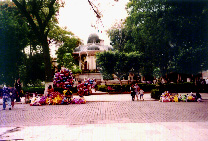 | HISTORY |
Within the multicultural mosaic of our country, Oaxaca occupies a very special place. Heiress of the Mixtec and Zapotec cultures, its roots sink deeply into mesoamerican times. In this crucible has melted the 16 indigenous groups found within the seven distinct regions of our State, but the Mestizo culture that followed the Spanish Conquest. Oaxaca is a point of encounter between the different cultures of Mexico and the World, a test of and a testament to the spiritual reserve of the Mexican people.
The villages that form this marvellous mix, the only one in the world in such a very small geographical place, have existed for thousands of years: the Zapotec, Mixtecs, Mazatecs, Chinantecas, Triquis, Chontales, Chatinos, Mixes, Amuzgos, Huaves, Zoques, Chontales, Chatinos, Ixtaltecas, Chonchos, Popolacas, Cuicatecas and Nahuas.The Capital City was founded in the year 1486 by the troops of Ahu�zotl, an Aztec Emperor. Following an alliance, after wars with the Mixtecs and Zapotecs, the new owners of the valley settled down in a fort on the Fortin Mountain, where today we celebrate Lunes del Cerro ("Monday of the Hill").
Oaxaca derives its name from Huaxyacac (Nahualt for "the place of the seed pods"): it is said that the mountain was covered with trees bearing long seed pods.After the defeat of Tenochtitl�n Hern�n Cort�s sent people to Oaxaca looking for gold, including Franciso Orozco in November of 1521. After one gold hunting expedition to Tututepec, in the Mixtec coast of the Pacific Ocean, Orozco came back to the Oaxaca Valley because of the beautiful weather.
Cort�s was against the foundation of Oaxaca, because he was not convinced it could be secured from his main base in Coyoacan. In the year 1526 the spaniards that lived in these lands against the will of the conqueror sent the king a letter, asking him to recognize the foundation of the city.
In 1528 while Cort�s was in Spain, the royal court changed the name to the town of Huaxyacac to Antequera, and a charter was issued in 1529.
Alonso Garc�a Bravo did the first mapping of the City and the first mayor, Don Juan Pel�ez de Berrio, gave land to the first 120 families of the spaniards and the allied indigenous people.
On April 25, 1532, the king of Spain named the village City of Oaxaca.
The City of Oaxaca contains both civilizations: on one side Monte Alban spiritual symbol of the ancient Mexico and on the other, the spiritual presence of the beautiful art and architecture of the missionaries, especially the Dominicans.
These two energies make Oaxaca a very special place because of the mixture of the indigenous and the occidental culture.
This rich inheritance, part of the Cultural Patrimony of the village of Oaxaca, it has been undefeated by earthqueakes and other forces of nature.
This is the product of the spiritual strengths that live in the hearth and feelings of the Oaxacans who have built a majestic City and a spiritual force that guarantees the future.
The City of Oaxaca has a lot of traditions, festivals, customs, churches, markets and homes, as do the suburbs and villages around Oaxaca, which maintain the human dimension against the advances of the modern world.
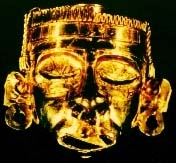 |
MUSEUMS & CULTURAL ORGANIZATIONS
|
Museum of Contemporary Art
The Museum of Contemporary Art is located in the colonial House of Cortes, an elegant mansion built at the end of XVII and beginning of the XVIII centuries. It is located at Alcala Street 202, between Morelos Avenue and Murguía St.
Permanent displays include work of famous Oaxacan artists, including Rufino Tamaño, Francisco Morales, Francisco Toledo, Francisco Gutierrez, Rodolfo Nieto and Rodolfo Morales.
There are also temporary exhibitions of other cultural events, a good library, and a pleasant courtyard café out the back.
Hours: The museum is open every day except Tuesdays from 10:30 am to 8:00 pm. Workshops in plastic arts are offered for children on Saturdays from 11:00 am to 12:30 pm.
Macedonio Alcalá 202, Centro, Oaxaca. Tel: (951) 41055/42818
Regional Museum of Oaxaca
The Regional Museum of Oaxaca is housed in a beautiful green stone building attached to Santo Domingo Church. 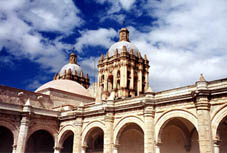 It contains the Zapotec treasures from Tomb Seven at Monte Albán. This and other archaeological sections make the most sense if you visit them after seeing some sites in the Central Valleys. It contains the Zapotec treasures from Tomb Seven at Monte Albán. This and other archaeological sections make the most sense if you visit them after seeing some sites in the Central Valleys.
The Mixtec trove on the museum's lower floor dates from the mid 14th century, when the Mixtecs reused an old Zapotec tomb at Monte Albán to bury one of their kings and his sacrificed servants. Together with the bodies they placed a hoard of beautifully-worked silver, turquoise, coral, jade, amber, jet, pearls, finely carved jaguar and eagle bone, and gold. It was discovered in 1932 by Alfonso Caso. Other sections of the museum cover the history of Oaxaca State since the Spanish conquest, the state�s Indian people, its archaeology and the history of the Dominican order.
Hours: The museum is generally open from 10 am. to 8 pm., Tuesday to Sunday. Entry is 20 pesos free on Sunday and holidays.
Cultural Center of Oaxaca
The Cultural Center of Oaxaca is located at the corner of Reforma and Constitution Streets, next to Santo Domingo Church.
In 1993 former monastery buildings and land behind Santo Domingo, which had been in military use for over a century, were handed over to the Oaxaca State Government.
The site is being transformed into a cultural center with a Oaxacan botanical garden, a regional plastic art school, and added space for the regional museum.
Museo Rufino Tamayo 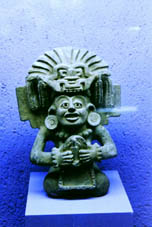 The museum is a fine old house located at Morelos 503, donated to Oaxaca by the artist Rufino Tamayo. It focuses on the aesthetic qualities of pre-hispanic artifacts and is arranged to trace artistic developments in the pre-conquest era. It is strong on the Pre-classic era and lesser-known civilizations like Veracruz. The museum is a fine old house located at Morelos 503, donated to Oaxaca by the artist Rufino Tamayo. It focuses on the aesthetic qualities of pre-hispanic artifacts and is arranged to trace artistic developments in the pre-conquest era. It is strong on the Pre-classic era and lesser-known civilizations like Veracruz.
Hours: 10 am. to 2 pm. and from 4 pm. to 7 pm. everyday. Sunday 10 am. to 3 pm. Closed Tuesdays. Admission is 14 pesos.
Address: Av. Morelos 503, Centro, Oaxaca, Oax.
The Alvarez Bravo Photographic Center
The Alvarez Bravo Photographic Center is housed in a stately 18th century building bought and renovated by the artist Francisco Toledo. It opened its doors to the public on September 17, 1996. It is a non-profit organization, and one of a number of new cultural centers promoting artistic and cultural values from all over Mexico.
It is also dedicated to research, education, conservation and exhibition of photographic works from all over the world.
The Center has one permanent exhibition room showing works by Manuel Alvarez Bravo himself, and three temporary exhibition rooms. The exhibitors to date include Keith Carter, Henri Cartier Bresson, Joseph Koudelka, Man Ray, Walter Reuter and Sebastiao Salgado. The Center is also host to a range of other activities: lectures, book presentations, workshops, film shows and guided visits. Thanks to donations and purchases of other collections, the Center's own collection is expanding.
The Photographic Center promotes the recovery and conservation of photographic archives, the creation of photographic documentation on different topics, and the publication of archives and exhibition catalogs. Its specialist library is an excellent starting point for photography-related research. In addition, you will encounter a dark room, a fonotech where you can consult Classic, Jazz, Popular and Ethnic music as well as music books, and the "Jorge Luis Borges" library for the visually impaired with over 500 titles in Braille writing.
Hours: It is open Monday to Sunday from 9:30 am to 6 pm. It is closed on Tuesdays.
Address: Murguía 302, Centro, CP. 68000, Oaxaca, Oax. México. Teléfono: (951) 41933 Fax: (951) 64523
Museo de Filatelia de Oaxaca A.C.
This museum, the first of its kind in Mexico, is a private initiative established in Oaxaca with the aim of supporting education and knowledge for collecting.
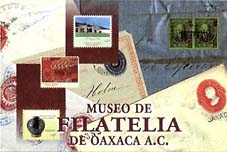 This new institution will house the permanent collection, formed by donations, that includes a rich selection of Mexican and Oaxacan stamps, as well as a small selection from many other countries.
This new institution will house the permanent collection, formed by donations, that includes a rich selection of Mexican and Oaxacan stamps, as well as a small selection from many other countries.
A special room has been designed to preserve philatelic material. This material will restored in a series of cabinets that will allow the specialist to do research, while interested visitors get plenty of viewing access.
Temporary exhibitions will take place at the Salón de Usos Múltiples, as well as lectures and different cultural activities, to introduce the audience to the endless world of philately.
The museum will also serve the purpose of being a meeting spot for amateur and expert philatists in Mexican stamps.
The library houses the Jose Lorenzo Cossio y Cosio�s (1902-1975) personal library. This collection contains books and documents about the postal history of Mexico, specialized magazines, auctions, catalogues, bulletins of the five continents, and contemporary publications for consulting.
Location:
The Museo de Filatelia is located in Oaxaca, one of Mexico�s most attractive and culturally rich cities; just behind the famous Ex-convent of Santo Domingo de Guzmán.
The museum, recently reconstructed in the traditional oaxacan architectural style, fulfills all the preservation requirements for collection.
Services:
The museum offers a mail service and a museum shop where you can buy stamps, books, post-cards, among other philatelic items, and a cafeteria where you can enjoy refreshments.
Hours:
It is open from Tuesday to Sunday from 9 am. to 7 pm.
Address: Reforma # 504, Centro, CP. 68000, Oaxaca, Oax. México. Tel: (951) 68028
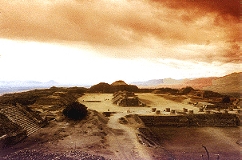
ARCHAEOLOGICAL SITES
Oaxaca is well known for it's Pre-Columbian civilizations of which the Zapotec and Mixtec have left a lasting legacy with over 4,000 known archaelogical sites. Monte Alban, Mitla and Yagul are the main attractions for most visitors, but Lambityeco and Zaachila are also worthwhile for those interested. All sites are within 30 miles of Oaxaca City and tours or public buses are available.
 Monte Alban Monte Alban
One of Mexico's greatest archaeological sites
 Mitla Mitla
Famous geometrical designs & architecture
 Yagul Yagul
Scenic location on hillside of Oaxaca valley
 Lambityeco Lambityeco
Important Zapotec marketplace
 Zaachila Zaachila
Last Zapotec capital before arrival of Spanish
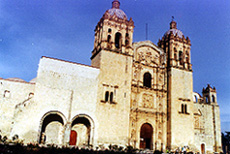
|
CHURCHES & BUILDINGS
|
OAXACA'S TEMPLES, CATHEDRALS AND CHURCHES
Oaxacan life is one rich in spiritual traditions, as evidenced by the more than two dozen temples in the city's center alone. Cathedral-like or on a more modest scale, Oaxaca's temples manage to be both magnificent and humble at the same time. Many Oaxaque�os still cross themselves as they pass to keep themselves mindful of the sacred. Weddings, baptisms, confirmations, first communions and "Quince A�os" (coming-out parties for 15 year old girls) are common occurrences that fill Oaxaca's churches with music and store-bought-best clothing and coiffures. Accounts of statues of virgins shedding actual tears are not unheard of, and miracles are often considered part of daily life.
CHURCH AND EX-CONVENT OF SANTO DOMINGO
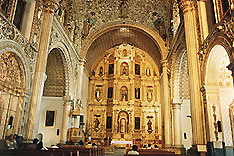 Inside Santo Domingo
The temple of Santo Domingo, located 5 short blocks north of the Z�calo on Alcala, is considered one of Mexico's finest examples of Baroque architecture. It's a massive structure that occupies several city blocks and pretty much dominates the city's skyline, if you're lucky enough to have a second or third story view. Still a lively center of Oaxacan spiritual and cultural life, Santo Domingo boasts a dazzling gold-leaf interior, and numerous biblical scenes and elaborate tributes to saints, martyrs, and the church's benefactors. Construction was begun in the mid 1500's by the Dominican order, and first opened in 1608. Although earth-quake proof, parts were damaged in wars but have been restored. The adjacent monastery is now the home of Oaxaca's Regional Museum.
Inside Santo Domingo
The temple of Santo Domingo, located 5 short blocks north of the Z�calo on Alcala, is considered one of Mexico's finest examples of Baroque architecture. It's a massive structure that occupies several city blocks and pretty much dominates the city's skyline, if you're lucky enough to have a second or third story view. Still a lively center of Oaxacan spiritual and cultural life, Santo Domingo boasts a dazzling gold-leaf interior, and numerous biblical scenes and elaborate tributes to saints, martyrs, and the church's benefactors. Construction was begun in the mid 1500's by the Dominican order, and first opened in 1608. Although earth-quake proof, parts were damaged in wars but have been restored. The adjacent monastery is now the home of Oaxaca's Regional Museum.
BASILICA OF NUESTRO SENORA DE LA SOLEDAD Soledad Church near the Zocalo
Soledad Church near the Zocalo
(Independenc�a 107 at Galeana; west of the Z�calo). Another fine example of Baroque architecture, La Soledad was constructed in the late 17th century (approx. 1682-1718). It is named after the patron saint of Oaxaca, Our Lady of Solitude, who is famed for her healing powers and whose likeness reigns over the main altar. Next to the Basilica is a the small Museo Religioso de la Soledad, and in front, a tranquil plaza. Beyond the plaza's walls are a number of stalls selling religious images and paraphernalia, as well as some of Oaxaca's best ice-cream.
OAXACA'S CATHEDRAL
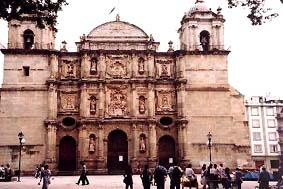 Located in the heart of the Z�calo, Oaxaca's Cathedral was first initiated in the mid 1600's (1640) and underwent a series of setback and reconstructions after earthquakes and pillages. The beautifully carved facade depicts scenes of the Rising of the crowned Virgin, while the interior houses a bronze altar imported from Italy, an antique pipe organ, and various graceful paintings from the 18th century. The huge clock on the south wall still chimes faithfully every 15 minutes as it has since it's installation in 1755.
Located in the heart of the Z�calo, Oaxaca's Cathedral was first initiated in the mid 1600's (1640) and underwent a series of setback and reconstructions after earthquakes and pillages. The beautifully carved facade depicts scenes of the Rising of the crowned Virgin, while the interior houses a bronze altar imported from Italy, an antique pipe organ, and various graceful paintings from the 18th century. The huge clock on the south wall still chimes faithfully every 15 minutes as it has since it's installation in 1755.
CUILAPAN DE GUERRERO
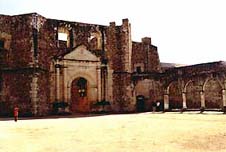 Located approximately 14k from downtown Oaxaca, Cuilapan is a hauntingly beautiful, hulking ruin of a 16th century Dominican convent. A glimpse of a still-intact original fresco in the cloister can be had if you ask the amiable groundskeeper, and the chapel is still used for local services.
Located approximately 14k from downtown Oaxaca, Cuilapan is a hauntingly beautiful, hulking ruin of a 16th century Dominican convent. A glimpse of a still-intact original fresco in the cloister can be had if you ask the amiable groundskeeper, and the chapel is still used for local services.
OTHER TEMPLES OF NOTEStrolling through Oaxaca's center and surrounding neighborhoods will bring you to the doorsteps of many lesser known but fantastic temples and sacred spaces. The following is not meant to be a definitive list; please make use of local offices of tourism for directions and background information. Don't forget to also visit the temples in villages like Tlacochahuaya, Tlacolula, Teotitl�n del Valle, and Ocotl�n, to name but a few.
- Temple of San Felipe Neri
- Temple and Exconvent of San Agust�n
- Temple and Exconvent of Carmen Alto
- Temple and Exconvent of Compa��a de Jes�s
- Temple of San Juan de Dios
- Temple of Carmen Bajo
- Temple of the Sangre de Cristo
- Temple and Exconvent of San Francisco
- Temple of Se�ora de las Nives,
- Temple of San Mat�as en Jalatlaco
- Temple and Exconvent of the Merced
- Temple de la Defensa
- Temple of Santa Mar�a del Marquesado
- Temple and Exconvent of Guadalupe
- Temple and Exconvent of San Cosme y San Dami�n
- Temple of the Consolaci�n
- Temple of Nuestra Se�ora del Patrociniio
- Temple of the Trinidad de las Huertas
- Temple of Santo Tom�s Xochimilco
- Chapel of the Sagrado Coraz�n de Jes�s
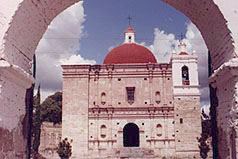
The Church at Mitla
|